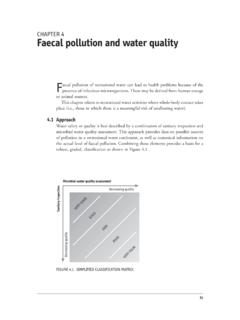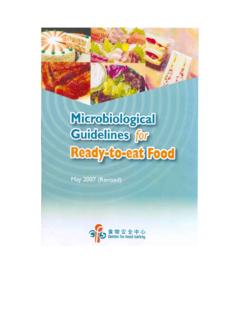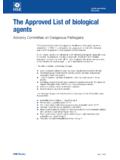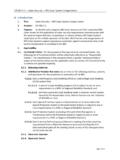Transcription of Great Crested Newt Habitat Suitability Index …
1 1 Great Crested Newt Habitat Suitability Index Background The Habitat Suitability Index (HSI) for the Great Crested newt was developed by Oldham et al. (2000). HSI scoring systems were originally developed by the US Fish and Wildlife Service as a means of evaluating Habitat quality and quantity. An HSI is a numerical Index , between 0 and 1. 0 indicates unsuitable Habitat , 1 represents optimal Habitat . The HSI for the Great Crested newt incorporates ten Suitability indices, all of which are factors thought to affect Great Crested newts. These ten Suitability indices are retained in this current Guidance Note.
2 The HSI system proposed by Oldham et al. (2000) is fairly easy to use. However, one Suitability Index (SI9, terrestrial) involves a more lengthy measurement and calculation than the other factors. In using the HSI system with volunteer surveyors in Kent, Lee Brady substituted a simpler evaluation of terrestrial Habitat quality, a four-point scale. Volunteers have found this modified HSI relatively easy to use. Several other, local, surveys have utilised the HSI, but utilised their own variations on the original system. In 2007, a workshop was held at the Herpetofauna Workers Meeting to evaluate the use of the HSI for the Great Crested newt, with the aims of: identifying components of the system that may need clarification or refinement agreeing on a standard that can be easily used by volunteers and professionals alike.
3 A conservative approach has been adopted in modifying the use of the original HSI Suitability indices. Use and limitations of HSI The HSI for Great Crested newts is a measure of Habitat Suitability . It is not a substitute for newt surveys. In general, ponds with high HSI scores are more likely to support Great Crested newts than those with low scores. However, the system is not sufficiently precise to allow the conclusion that any particular pond with a high score will support newts, or that any pond with a low score will not do so. There is also a positive correlation between HSI scores and the numbers of Great Crested newts observed in ponds.
4 So, in general, high HSI scores are likely to be associated with greater numbers of Great Crested newts. However, the relationship is not sufficiently strong to allow predictions to be made about the numbers of newts in any particular pond. HSI scoring can be useful in: Evaluating the general Suitability of a sample of ponds for Great Crested newts Comparing general Suitability of ponds across different areas Evaluating the Suitability of receptor ponds in a proposed mitigation scheme. How to collect data and calculate HSI The HSI is a geometric mean of ten Suitability indices: HSI = (SI1 x SI2 x SI3 x SI4 x SI5 x SI6 x SI7 x SI8 x SI9 x SI10)1/10 The ten Suitability Indices are scored for a pond, in the field and from map work.
5 The ten field scores are then converted to SI scores, on a scale from to 1 ( is used as the bottom end of the range in stead of 0, because multiplying by 0 reduces all other SI scores to 0). The ten SI scores are then multiplied together. The tenth root of this number is then calculated (X)1/10 The calculated HSI for a pond should score between 0 and 1. Some of the field scores are categorical, some are numerical. The numerical field scores are converted to SI scores by reading off the values from graphs produced by Oldham et al. (2000) reproduced in this Guidance Note.
6 The field scores are the data that should be collected by a surveyor. A summary of data to collect is given in Summary of scoring system below. More full details of the scoring system, including descriptions of the criteria used in the categorical scores are given in Details of Suitability Indices and Definitions of Categories. Two of the SI sores (SI1 and SI8) can be carried out as desktop/map exercises and so do not have to be completed in the field. The remaining SI scores should be recorded as field scores, and later converted to Suitability indices, in some cases reading SI scores from the graphs provided in Details of Suitability Indices and Definitions of Categories.
7 Categorisation of HSI scores Lee Brady has developed a system for using HSI scores to define pond Suitability for Great Crested newts on a categorical scale: HSI Pond Suitability < = poor = below average = average = good > = excellent 2 3 Summary of scoring system SI1 Location Field score SI A (optimal) 1 B (marginal) C (unsuitable) SI2 Pond area Field score SI Measure pond surface area (m2) and round to nearest 50 m2 Read off graph.
8 SI3 Pond drying Field score SI Criteria Never Never dries Rarely Dries no more than two years in ten or only in drought. Sometimes Dries between three years in ten to most years Annually Dries annually SI4 Water quality Field score SI Criteria Good Abundant and diverse invertebrate community. Moderate Moderate invertebrate diversity Poor Low invertebrate diversity, few submerged plants Bad Clearly polluted, only pollution-tolerant invertebrates, no submerged plants.
9 SI5 Shade Field score SI Estimate percentage perimeter shaded to a least 1 m from shore. Read off graph. SI6 Fowl Field score SI Criteria Absent 1 No evidence of water fowl (although moorhen may be present) Minor Waterfowl present, but little sign of impacts Major Severe impact of waterfowl SI7 Fish Category SI Criteria Absent 1 No records of fish stocking and no fish revealed during survey. Possible No evidence of fish, but local conditions suggest that they may be present. Minor Small numbers of crucian carp, goldfish or stickleback known to be present.
10 Major Dense populations of fish known to be present. SI8 Ponds Field score SI Count the number of ponds within 1 km of survey pond, not separated by major barriers, and divide by This can be done from maps rather than in the field. Read off graph. SI9 Terrestrial Habitat Field score SI Good 1 Moderate Poor None SI10 Macrophytes Field score SI Estimate the percentage of the pond surface area occupied by macrophyte cover (between May and the end of September) Read off graph.





